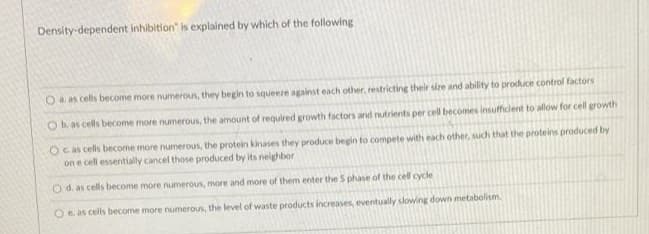Density-dependent inhibition" is explained by which of the following O as cells become more numerous, they begin to squeeze against each other, restricting their sire and ability to produce control factors Ohas cells become more numerous, the amount of required growth factors and nutrients per cell becomes insufficient to allow for cel growth Ocas cells become more numerous, the protein kinases they produce begin to compete with each other, such that the proteins produced by on e cel essentially cancel those produced by its neighbor Od. as cells become more numerous, more and more of them enter the S phase of the cell cycle Oe as cells become more numerous, the level of waste products increases, eventually slowing down metabolism
Density-dependent inhibition" is explained by which of the following O as cells become more numerous, they begin to squeeze against each other, restricting their sire and ability to produce control factors Ohas cells become more numerous, the amount of required growth factors and nutrients per cell becomes insufficient to allow for cel growth Ocas cells become more numerous, the protein kinases they produce begin to compete with each other, such that the proteins produced by on e cel essentially cancel those produced by its neighbor Od. as cells become more numerous, more and more of them enter the S phase of the cell cycle Oe as cells become more numerous, the level of waste products increases, eventually slowing down metabolism
Human Anatomy & Physiology (11th Edition)
11th Edition
ISBN:9780134580999
Author:Elaine N. Marieb, Katja N. Hoehn
Publisher:Elaine N. Marieb, Katja N. Hoehn
Chapter1: The Human Body: An Orientation
Section: Chapter Questions
Problem 1RQ: The correct sequence of levels forming the structural hierarchy is A. (a) organ, organ system,...
Related questions
Concept explainers
Oogenesis
The formation of the ovum (mature female gamete) from undifferentiated germ cells is called oogenesis. This process takes place in the ovaries (female gonads). Oogenesis consists of three stages known as the multiplication phase, growth phase, and maturation phase.
Cell Division
Cell division involves the formation of new daughter cells from the parent cells. It is a part of the cell cycle that takes place in both prokaryotic and eukaryotic organisms. Cell division is required for three main reasons:
Question

Transcribed Image Text:Density-dependent inhibition" is explained by which of the following
Oa. as cells become more numerous, they begin to squeere against each other, restricting their size and ability to produce control factors
Ob as cells become more numerous, the amount of required growth factors and nutrients per cell becomes insufficient to allow for cel growth
Oc as cells become more numerous, the protein kinases they produce begin to compete with each other, such that the proteins produced by
on e cell essentially cancel those produced by its neighbor
O d. as cells become more numerous, more and more of them enter the S phase of the cell cycle
Oe as cells become more numerous, the level of waste products increases, eventually slowing down metabolism.
Expert Solution
This question has been solved!
Explore an expertly crafted, step-by-step solution for a thorough understanding of key concepts.
This is a popular solution!
Trending now
This is a popular solution!
Step by step
Solved in 3 steps

Knowledge Booster
Learn more about
Need a deep-dive on the concept behind this application? Look no further. Learn more about this topic, biology and related others by exploring similar questions and additional content below.Recommended textbooks for you

Human Anatomy & Physiology (11th Edition)
Biology
ISBN:
9780134580999
Author:
Elaine N. Marieb, Katja N. Hoehn
Publisher:
PEARSON

Biology 2e
Biology
ISBN:
9781947172517
Author:
Matthew Douglas, Jung Choi, Mary Ann Clark
Publisher:
OpenStax

Anatomy & Physiology
Biology
ISBN:
9781259398629
Author:
McKinley, Michael P., O'loughlin, Valerie Dean, Bidle, Theresa Stouter
Publisher:
Mcgraw Hill Education,

Human Anatomy & Physiology (11th Edition)
Biology
ISBN:
9780134580999
Author:
Elaine N. Marieb, Katja N. Hoehn
Publisher:
PEARSON

Biology 2e
Biology
ISBN:
9781947172517
Author:
Matthew Douglas, Jung Choi, Mary Ann Clark
Publisher:
OpenStax

Anatomy & Physiology
Biology
ISBN:
9781259398629
Author:
McKinley, Michael P., O'loughlin, Valerie Dean, Bidle, Theresa Stouter
Publisher:
Mcgraw Hill Education,

Molecular Biology of the Cell (Sixth Edition)
Biology
ISBN:
9780815344322
Author:
Bruce Alberts, Alexander D. Johnson, Julian Lewis, David Morgan, Martin Raff, Keith Roberts, Peter Walter
Publisher:
W. W. Norton & Company

Laboratory Manual For Human Anatomy & Physiology
Biology
ISBN:
9781260159363
Author:
Martin, Terry R., Prentice-craver, Cynthia
Publisher:
McGraw-Hill Publishing Co.

Inquiry Into Life (16th Edition)
Biology
ISBN:
9781260231700
Author:
Sylvia S. Mader, Michael Windelspecht
Publisher:
McGraw Hill Education